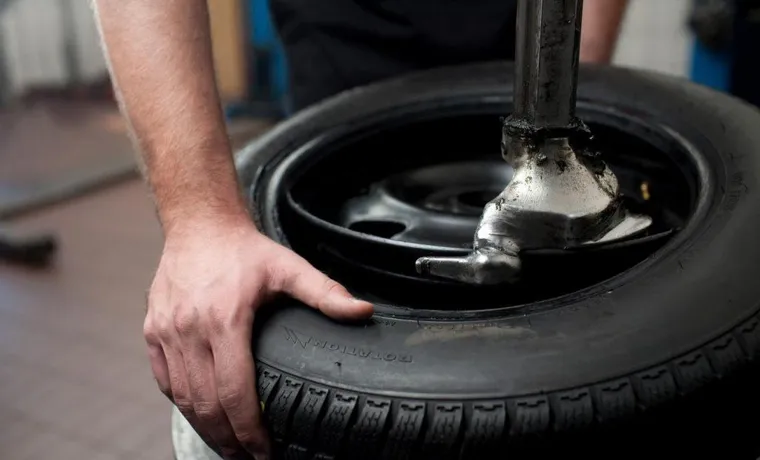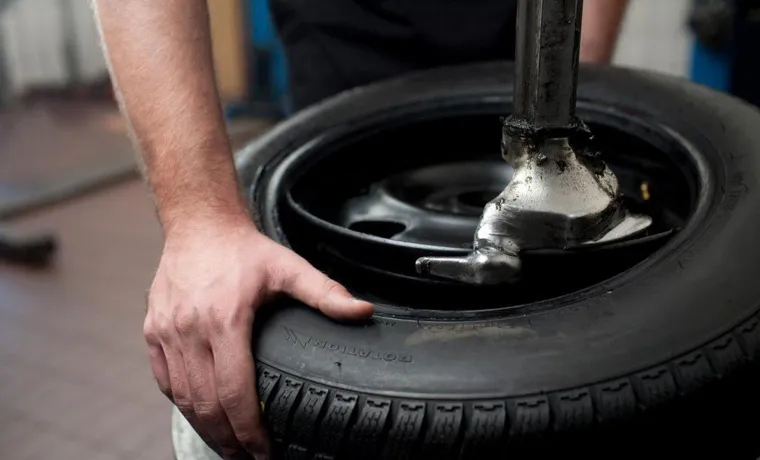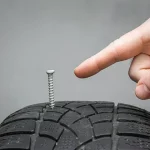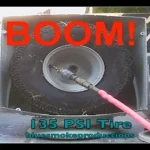Tire leaks can be incredibly frustrating, especially when they’re happening around the rim. Not only can they damage your tires and potentially cause blowouts, but they can also make for an uncomfortable and noisy ride. Thankfully, there are things you can do to prevent and stop tire leaks around the rim – and we’ve got some tips and tricks to help you out.
First and foremost, it’s important to make sure that your tires are properly inflated. Underinflated tires can put extra stress on the rims, which can lead to leaks over time. Additionally, if your tires are overinflated, they can be more susceptible to punctures and other damage.
Check your tire pressure regularly and adjust as needed to help prevent leaks. Another key factor in preventing tire leaks is proper maintenance. Regularly inspecting your tires for damage or wear and tear can go a long way in catching issues before they become major problems.
Make sure your tires are properly aligned and balanced, and consider rotating them regularly to ensure even wear. If you do experience a tire leak around the rim, there are several options for stopping it. One common trick is to use a sealant designed specifically for tires.
These products can help plug up small holes and prevent air from escaping. Another option is to use a tire patch kit, which can be found at most auto supply stores. These kits typically include a patch and adhesive, and can be used to repair larger punctures or damage.
Ultimately, the key to preventing and stopping tire leaks around the rim is proper maintenance and vigilance. By taking care of your tires and keeping an eye out for any issues, you can help ensure a smooth, safe ride every time you hit the road.
Table of Contents
Identify the cause
If you’re experiencing a tire leak around the rim, the first step is to identify the cause. This can be caused by a variety of issues, including a damaged valve stem, a cracked rim, or a faulty seal between the tire and rim. To determine the cause of the leak, start by closely inspecting the tire and rim for any visible signs of damage or wear.
If you notice any cracks, chips, or other damage, it may be time to replace your tire or rim. Alternatively, if the damage appears to be minor, you may be able to seal the leak using a tire sealant or by tightening the valve stem. Remember, it’s important to address any tire leaks promptly, as they can cause your tire to lose air pressure and lead to unsafe driving conditions.
With a little detective work and some quick action, you can get back on the road with a properly sealed tire.
Check for corrosion or wear on the rim and valve stem
When it comes to your vehicle’s safety, checking your tires for any potential issues is crucial. One of the most important things to look out for is corrosion or wear on the rim and valve stem. This can cause problems such as air leaks, tire punctures, and even tire blowouts.
So, what can be the cause of this corrosion or wear? One of the main culprits is exposure to the elements. Over time, the constant exposure to rain, snow, salt, and other harsh elements can cause tire rims and valve stems to corrode and wear down. Another common cause of corrosion is contact with chemicals such as brake fluid, oil, and cleaning solutions.
These chemicals can eat away at the metal, causing it to weaken over time. In addition to external factors, internal issues can also contribute to corrosion and wear on the rim and valve stem. For example, if the tire is not properly balanced, it can cause uneven wear on the rim.
This can also occur if the tire pressure is not properly maintained. Overinflated tires can put extra stress on the rim and valve stem, while underinflated tires can cause the tire to wear down unevenly and put extra stress on the valve stem. In conclusion, identifying the cause of corrosion and wear on the tire rim and valve stem is necessary to ensure the safety and longevity of your vehicle.
By properly maintaining tire pressure, avoiding exposure to harsh elements and chemicals, and addressing any internal issues promptly, you can prevent potential issues and keep your vehicle running smoothly.

Inspect the tire for punctures or damage
Inspecting your tire for punctures or damage is an essential step in maintaining your vehicle’s safety and performance. When checking for any damage, it’s crucial to identify the cause. Is it a nail or a piece of glass that’s caused the puncture? Has your tire hit a curb or pothole that’s resulted in visible damage? It’s important to figure out the cause because it may indicate potential problems with your vehicle or driving habits.
For instance, driving on worn-out or bald tires can increase the likelihood of punctures or damage. Similarly, hitting curbs or potholes frequently can lead to alignment issues that could cause further tire damage. By identifying the cause, you can take the necessary steps to prevent future damage and ensure your vehicle runs smoothly.
So, the next time you inspect your tire, take a moment to identify the cause of any punctures or damage, and address it proactively to avoid any additional issues down the road.
Clean the wheel and tire
If you’re experiencing a tire leak around the rim, one of the first steps you can take is to clean the wheel and tire. Start by removing the wheel from your vehicle and using a stiff-bristled brush to scrub away any dirt or grime that may have accumulated. Be sure to pay special attention to the area around the rim where the tire meets the wheel.
This can be a prime spot for debris to collect and cause leaks. Once the wheel is clean, inspect the tire for any damage or wear. If you notice any cracks or punctures, it’s best to replace the tire rather than attempting to repair it.
By taking these steps to clean and inspect your wheel and tire, you can help prevent future leaks and keep your vehicle running smoothly.
Remove debris and residue with soap and water
When it comes to keeping your car wheels and tires in top shape, cleaning them regularly is a must. To do this, start by removing any debris and residue with soap and water. Mix a mild detergent with warm water and apply it to the wheel and tire using a soft brush or sponge.
Use the brush to scrub the wheel thoroughly, paying special attention to the crevices and hard-to-reach areas. Rinse the wheel and tire with clean water, making sure to remove all traces of soap. Once dry, inspect the wheel and tire for any signs of damage or wear and tear.
If you notice any issues, it may be time to schedule a visit to your local mechanic. By taking the time to clean your wheels and tires regularly, you can keep them looking great and functioning properly, making your car a joy to drive.
Use a wire brush to remove rust or corrosion
When cleaning your car’s wheels and tires, it’s important to ensure that they’re free from rust or corrosion, especially if you live in an area with harsh weather conditions or salty roads. To clean the wheel and tire, use a wire brush to remove any rust or corrosion that may have accumulated over time. This will help to prevent further damage and ensure that your wheels and tires remain in good condition.
Start by brushing away any loose debris or dirt, and then use the wire brush to gently scrub away any rust or corrosion. Be sure to run the wire brush over the entire surface of the wheel and tire, paying special attention to any areas that may be particularly prone to rust or corrosion. Once you’ve finished brushing the wheel and tire, rinse it clean with water and dry it off with a towel.
With a little bit of elbow grease and the right tools, you can keep your wheels and tires looking great for years to come.
Dry the area thoroughly
After cleaning your wheel and tire thoroughly with soap and water, it’s important to dry the area thoroughly to avoid any water spots or streaks. You can either let it air dry or use a clean microfiber towel to wipe it down. Make sure to get into all the nooks and crannies to ensure that the entire area is dry.
If there are any areas that are difficult to reach, use a blower or compressed air to dry them out. Once you’ve dried the area, you can move on to applying a tire shine or wax to give your wheels and tires a shiny finish. Remember, keeping your wheels and tires clean and shiny not only enhances the appearance of your vehicle, but also protects them from damage and extends their lifespan.
So make sure to take the time to give them the attention they deserve!
Seal the rim
If you notice that your tire is leaking around the rim, it’s important to take action immediately. One of the most common causes of this issue is a gap between the tire and the rim, which can occur over time due to wear and tear. Fortunately, there’s a simple solution: seal the rim.
This can be done using a specially designed sealant, which is applied to the inside of the tire. Once the sealant dries, it creates a watertight seal that prevents air from escaping and water from entering. Not only does this prevent leaks, but it also helps to extend the life of your tire by reducing the amount of wear and tear on the rim.
So, if you’re dealing with a leaking tire, don’t wait – seal the rim as soon as possible to keep your vehicle safe and secure on the road.
Apply a bead of rubber cement along the edge of the rim
When dealing with bike flat tires, it’s important to seal the rim properly to avoid further damage. How can you do that? Simple! Apply a bead of high-quality rubber cement along the edge of the rim. Ensure you spread out the cement evenly and let it dry for a few seconds before placing the inner tube back into the tire.
This simple step will ensure that when you inflate the tire, no air will escape between the rim and the tube. A properly sealed rim guarantees you a safer, comfortable ride, and minimizes the chances of accidents caused by unpredictable blowouts. Therefore, always make sure to use the best cement available to ensure that you’ve got the most secure seal possible.
Install a rim sealant strip to create an airtight seal
Installing a rim sealant strip is an excellent way to create an airtight seal and prevent any air from escaping. Not only does this contribute to a more energy-efficient home, but it also helps keep out any unwanted pests or pollutants. The process is straightforward and can be done with minimal effort.
The first step is to thoroughly clean the rim and remove any debris or dirt. Next, measure and cut the sealant strip to fit the size of the rim. Finally, attach the strip to the rim, ensuring that the seal is secure and tight.
With the rim now sealed, your home will benefit from better insulation and improved energy efficiency. It’s a simple solution that makes a significant impact, and your energy bills will thank you for it.
Replace the valve stem or tire
If you’re experiencing a tire that’s leaking around the rim, there are a few solutions that can be considered. One possibility is to replace the valve stem. The valve stem is a small rubber component that attaches to the rim and allows air to enter the tire.
Over time, these can become worn or damaged, leading to air leakage. To replace the valve stem, the tire must be removed from the rim and the old valve stem must be removed before the new one can be inserted and reassembled. Alternatively, if the valve stem seems to be intact and the tire is still leaking, it may be necessary to replace the tire entirely.
This might be the case if there is a puncture in the tire that cannot be repaired or if the tire itself is showing signs of age or wear. In either instance, it is best to consult a professional to ensure a safe replacement and prevent any further issues with the tire leaking around the rim.
If the leak persists, replace the valve stem
If you’re experiencing a pesky tire leak, it may be time to replace the valve stem. This fix is crucial for preventing further tire damage and maintaining optimal tire pressure. To determine if a faulty valve stem is causing your leak, check for any cracks or tears in the rubber.
If the valve stem appears worn or damaged, it’s best to replace the entire stem or the entire tire. While this may seem like a daunting task, it can be easily accomplished with the right tools and a bit of patience. Start by removing the tire from the rim and then removing the old valve stem.
Insert the new valve stem, making sure it’s tightly secured before reattaching the tire to the rim. By replacing the valve stem or tire, you can ensure that your car is safe to operate and that your tires remain in good condition. So next time you’re dealing with a tire leak, don’t hesitate to take action and replace the valve stem – it’s a simple fix that can make a big difference.
If the tire is severely damaged, replace the tire
If the tire on your vehicle is severely damaged, the best course of action is to replace it entirely. However, in some cases, you might be able to get away with replacing just the valve stem. The valve stem is the small rubber or metal piece that protrudes from the tire and is used to inflate and deflate it.
If the valve stem is damaged, it will cause your tire to lose air, making it unusable. Replacing the valve stem is a relatively simple process and can be done quickly by a professional. However, if your tire has a large puncture or tear, you will need to replace the entire tire.
Driving on a severely damaged tire can be dangerous, as it can lead to blowouts and accidents. When it comes to the safety of you and your passengers, it’s best not to take any chances. Always replace the tire if it is severely damaged and replace the valve stem when necessary.
Remember, safety first!
Final tips and considerations
So, you’ve finally stopped your tire from leaking around the rim. Congrats! However, to keep it that way, there are certain tips and tricks that must be considered. First, make sure you regularly check your tire’s air pressure and maintain it at the recommended level.
Additionally, avoid hitting curbs or potholes as much as possible. Any impact could cause damage to your tire, leading to leaks later on. It’s also important to ensure your rims are clean and free from debris, such as dirt or gravel, which can cause scratches and other forms of damage to your tire’s seal.
Finally, if the issue still persists, consider taking your tire to a professional mechanic who can inspect it thoroughly and offer a more permanent solution. By following these tips, you can be sure that your tire remains leak-free and in top shape for longer.
Maintain proper tire pressure and regularly check for leaks
Maintaining proper tire pressure and regularly checking for leaks are crucial for ensuring your safety on the road. Not only does it help improve fuel efficiency, but it also helps prevent blowouts, which can be dangerous. You should check your tire pressure at least once a month and before long trips.
Use a tire pressure gauge to check the pressure and inflate as needed. It’s also important to regularly inspect your tires for any leaks or punctures. Look for any objects embedded in the tire or any visible damage.
If you notice any leaks or damage, replace the tire immediately. Don’t forget to also rotate your tires every 6,000 to 8,000 miles to ensure even wear. By following these simple tips and regularly maintaining your tires, you can improve your safety, save on fuel costs, and extend the life of your tires.
Consider using an inner tube as a temporary fix
When it comes to bike tire punctures, there are a few things you can do to temporarily fix the problem. One option is to use an inner tube to patch up the punctured tire. Simply remove the punctured tube and replace it with the inner tube, making sure that the tube is properly inflated and the tire is securely attached to the rim.
This can give you some time to get to a bike shop or find a more permanent solution. However, it’s important to remember that this is only a temporary fix and you will eventually need to replace the punctured tire or tube. It’s also important to make sure that the inner tube is the correct size and type for your bike tire.
While this method may not work for all types of punctures, it’s worth considering as a quick solution.
Consult a professional if you are unable to solve the problem on your own
When it comes to solving problems, it’s important to know your limits. While many issues can be resolved through DIY solutions, some require the expertise of a professional. Whether it’s electrical work, plumbing, or even medical concerns, seeking assistance from a trained individual can save you time, money, and potential danger.
Don’t be afraid to admit when you’re in over your head and consult a professional to address the problem. Ignoring the issue or attempting to fix it yourself can lead to further complications and even greater expenses in the long run. Remember to research and vet any professionals you hire to ensure they are qualified and reputable.
In the end, seeking expert assistance when necessary is the smart and responsible choice.
Conclusion
So there you have it, folks! With these simple yet effective tips, you can easily stop your tire from leaking around the rim. From double-checking your valve stem to employing the good old-fashioned soap and water trick, you now have the tools to keep your tires inflated and your wheels rolling smoothly. And if all else fails, just remember: duct tape fixes everything (well, almost everything).
So go forth, dear readers, and conquer those pesky tire leaks like the confident DIY mechanic you are!”
FAQs
Why do tires leak around the rim?
Tires may leak around the rim due to a damaged valve stem, corrosion on the rim, or improper installation of the tire.
Can using a tire sealant stop a leak around the rim?
Yes, tire sealant can help seal small leaks around the rim. However, it is important to have the tire inspected and repaired by a professional as soon as possible.
How do I properly install a tire to prevent leaks around the rim?
To prevent leaks around the rim, make sure the tire is properly seated on the rim and the valve stem is tightened. It is also important to use the correct tire size and ensure the rim is free of corrosion.
Is it safe to continue driving with a tire that is leaking around the rim?
No, it is not safe to continue driving with a tire that is leaking around the rim. This can cause the tire to lose air pressure and potentially lead to a blowout.
Should I replace the tire or the rim if there is a leak around the rim?
It depends on the severity of the leak and the condition of the tire and rim. A professional tire technician should inspect the tire and rim to determine the best course of action.
How often should I check my tires for leaks and other issues?
It is recommended to check your tires for leaks and other issues at least once a month, and before any long road trips. This can help prevent issues like leaks around the rim.
What is the best way to prevent leaks around the rim?
To prevent leaks around the rim, make sure to properly maintain your tires and rims, avoid hitting potholes or curbs, and have any issues inspected and repaired by a professional as soon as possible.



